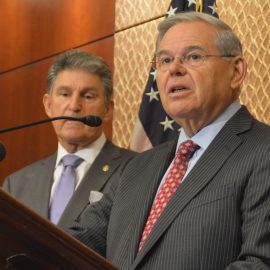

This article is an excerpt from the Shortform book guide to "Just Mercy" by Bryan Stevenson. Shortform has the world's best summaries and analyses of books you should be reading.
Like this article? Sign up for a free trial here.
How long was Walter McMillian in prison? When was Walter McMillian released?
Bryan Stevenson’s book Just Mercy studies the case of Walter McMillian, which he took on when he suspected McMillian was wrongfully convicted of a murder he was accused of. Stevenson was successful in freeing McMillian from death row, but it was a long process.
Keep reading to learn about the journey to free McMillian.
The Long Road to Exoneration
Via the Equal Justice Initiative, Stevenson began representing Walter McMillian shortly after his conviction. But when was Walter McMillian released? Despite various failed appeals from 1990 to 1993, McMillian was released from prison in 1993 after the Alabama Court of Criminal Appeals overturned his conviction. Yet, given the herculean effort needed to exonerate him, Stevenson suggests that the justice system is far too complacent regarding unjust convictions.
(Shortform note: One reason why McMillian’s exoneration took so long after his conviction is the convoluted appeals process for criminal convictions: First, state convictions are reviewed by smaller state-level appellate courts, and if the initial appeal is unsuccessful, defendants can appeal to the state’s highest appellate court. However, if the defendant can point to a federal issue in the ruling, they’re entitled to appeal at a federal appellate court; if this appeal also proves unsuccessful, they may appeal to the US Supreme Court as a final option.)
Stevenson first filed a brief to the Alabama Court of Criminal Appeals in 1991. In this appeal, he made various arguments: Myers’s testimony lacked credible corroboration; jury selection was racially discriminatory; the change of venue to Baldwin County was illicit; and finally, the judge’s use of judicial override was improper. However, the Court of Criminal Appeals rejected these arguments, upholding McMillian’s conviction and death sentence.
After the ruling, Stevenson and investigators uncovered more evidence of McMillian’s innocence. For example, they discovered that Hooks was paid $5,000 for his testimony and that the DA and Sheriff Tate released Hooks from prison the day after his testimony; they were legally obligated to disclose this information to the defense, but failed to.
(Shortform note: The legal requirement for prosecutors to disclose exculpatory information to the defense stems from 1963’s Brady v. Maryland, in which the US Supreme Court ruled that suppression of exculpatory evidence violates the defendant’s right to due process. Particularly relevant to McMillian’s case, however, was 1972’s Giglio v. United States, in which the Court unanimously ruled that deals made by the prosecution with key witnesses must also be disclosed to the defense. Consequently, the DA’s failure to disclose his deal with Hooks violated McMillian’s right to due process.)
Additionally, Myers contacted Stevenson directly and recanted his testimony. He further explained that Sheriff Tate and others had threatened him with the death penalty after his two previous recantations. In light of this evidence, Stevenson filed a Rule 32 petition, granting him access to all police and prosecutorial files.
In the Rule 32 hearing, Stevenson presented new evidence of McMillian’s innocence. In particular, he called Myers to the stand, who recanted his original testimony. He also called multiple witnesses who spent time in jail with Myers, whom Myers previously told that his original testimony was fabricated. Crucially, Stevenson presented tapes of Myers in police custody, where Sheriff Tate threatened him if he didn’t testify against McMillian, despite Myers protesting that he had nothing to do with the Morrison murder.
(Shortform note: While cases in state appellate courts permit review of records from the initial trial, Alabama’s Rule 32 allows for habeas corpus petitions, which can introduce information not mentioned in the original trial. In other words, Rule 32 petitions allow defendants to present new evidence establishing their innocence, which generally isn’t presented in appellate hearings.)
Nonetheless, the presiding judge denied McMillian relief, claiming there wasn’t sufficient evidence that Myers’s original testimony was fabricated. Consequently, Stevenson sought to appeal the decision in the Alabama Court of Criminal Appeals.
Meanwhile, Stevenson notes that the new DA—Tom Chapman—had grown doubtful of McMillian’s guilt, ordering an Alabama Bureau of Investigation (ABI) inquiry into the crime. Six months later, ABI investigators revealed their findings: McMillian didn’t kill Ronda Morrison. Six weeks after the ABI’s report, the Court of Criminal Appeals released its verdict: McMillian was wrongly convicted, and he deserved a new trial.
(Shortform note: Appellate courts are generally reticent to overturn the rulings of lower courts: In 2016, for instance, fewer than 7% of criminal appeals were successful. So, McMillian’s success in winning his appeal was somewhat anomalous.)
In light of the ABI’s report, however, DA Chapman chose not to re-prosecute McMillian. Rather, the State supported Stevenson’s motion to dismiss all charges against McMillian, leading to his immediate release. On March 2nd, 1993—nearly six years after his original arrest—McMillian was exonerated and released from prison.
(Shortform note: McMillian’s six years behind bars—though an undoubtedly long duration for a crime he didn’t commit—is less than the average amount of time spent in prison for exonerated death row survivors; researchers estimate that the average death row exoneree spends over 11 years in prison before exoneration.)
The Aftermath of Six Years on Death Row
Despite his exoneration, McMillian’s conviction and time in prison had lasting consequences. Indeed, Stevenson argues that McMillian’s unjust conviction caused him irreversible damage.
First, McMillian’s wife, Winnie, decided to separate from him, so he lived alone in a trailer in Monroe County after his release.
(Shortform note: Winnie’s decision to leave McMillian is representative of a larger trend, as researchers have found that incarcerations during a marriage makes divorce about twice as likely. Further, they found that the likelihood of divorce grows over 30% for each additional year behind bars.)
Moreover, although Stevenson filed a civil lawsuit against those involved in McMillian’s prosecution—like Sheriff Tate, the other investigators, and the DA—laws protecting state agents from civil liabilities made it difficult to win compensation. Altogether, McMillian received only a few hundred thousand dollars to compensate for six years imprisoned on death row.
(Shortform note: McMillian’s inability to win a civil suit against prosecutors stems from Imbler v. Pachtman, a 1976 case heard by the US Supreme Court. The Court unanimously ruled that prosecutors have absolute immunity from civil liabilities for actions committed in their role as prosecutors—even if they intentionally withheld information or knowingly used perjured testimony. In defense of this ruling, the Court argued that leaving prosecutors liable to civil suits would hinder their ability to work effectively, since they would constantly be defending against ill-founded lawsuits.)
Finally, Stevenson recalls that as McMillian grew older, he developed trauma-induced dementia, requiring constant care. However, because he was convicted of a felony, few nursing homes would accept him—even though he was exonerated. Further, though one nursing home let McMillian stay for 90 days, he suffered hallucinations of death row while there. Although he was released from death row, McMillian’s memories of it left him permanently scarred.
(Shortform note: McMillian’s trauma from his incarceration is hardly atypical; in a 2019 review of research studies, experts found that prisoners experience disproportionately high rates of potentially traumatic events (PTEs) during incarceration. Moreover, they found a statistically significant correlation between PTEs—especially time spent in solitary confinement—and post traumatic stress disorder (PTSD) among inmates.)

———End of Preview———
Like what you just read? Read the rest of the world's best book summary and analysis of Bryan Stevenson's "Just Mercy" at Shortform.
Here's what you'll find in our full Just Mercy summary:
- An examination of the justice system's failures toward marginalized populations
- Examples of criminal cases from history that illistrate the failures
- Possible solutions for repairing the justice system in America






